Self-Biased Bidomain LiNbO3/Ni/Metglas Magnetoelectric Current Sensor
Abstract
1. Introduction
2. Samples
3. Theoretical and Experimental Approach
3.1. Internal Fields in a Gradient Two-Layer Magnetostrictive Structure Nickel/Metglas 2826 MB
3.2. Flexural Mode of the ME Effect in the Gradient Structure of Bidomain LN/Ni/Metglas
4. Principle of Operation and Design of ME Current Sensor
5. Discussion
6. Conclusions
Author Contributions
Funding
Conflicts of Interest
Appendix A
Appendix A.1. Intrinsic Magnetic Fields in Gradient Bilayer Magnetostrictive Structure Ni/Metglas 2826MB

Appendix A.2. Bending Mode of ME Effect in Gradient Structure Metglas/Ni/bidomain LN
References
- Ripka, P.; Tipek, A. (Eds.) Modern Sensors Handbook; ISTE: London, UK, 2007; ISBN 9780470612231. [Google Scholar]
- Ouyang, Y.; He, J.; Hu, J.; Wang, S. A Current Sensor Based on the Giant Magnetoresistance Effect: Design and Potential Smart Grid Applications. Sensors 2012, 12, 15520–15541. [Google Scholar] [CrossRef]
- Ramsden, E. Hall-Effect Sensors: Theory and Application; Elsevier: Amsterdam, The Netherlands, 2011. [Google Scholar]
- Harshe, G.; Dougherty, J.O.; Newnham, R. Theoretical modelling of multilayer magnetoelectric composites. Int. J. Appl. Electromagn. Mater. 1993, 4, 145–154. [Google Scholar]
- Harshe, G. Theoretical Modeling of 3-0/0-3 Magnetoelectric Composites. Int. J. Appl. Electromagn. Mater. 1993, 4, 161–171. [Google Scholar]
- Bichurin, M.I.; Petrov, V.M.; Petrov, R.V.; Kiliba, Y.V.; Bukashev, F.I.; Smirnov, A.Y.; Eliseev, D.N. Magnetoelectric Sensor of Magnetic Field. Ferroelectrics 2002, 280, 199–202. [Google Scholar] [CrossRef]
- Nan, C.-W.; Bichurin, M.I.; Dong, S.; Viehland, D.; Srinivasan, G. Multiferroic magnetoelectric composites: Historical perspective, status, and future directions. J. Appl. Phys. 2008, 103, 31101. [Google Scholar] [CrossRef]
- Zhai, J.; Xing, Z.; Dong, S.; Li, J.; Viehland, D. Detection of pico-Tesla magnetic fields using magneto-electric sensors at room temperature. Appl. Phys. Lett. 2006, 88, 62510. [Google Scholar] [CrossRef]
- Viehland, D.; Wuttig, M.; McCord, J.; Quandt, E. Magnetoelectric magnetic field sensors. MRS Bull. 2018, 43, 834–840. [Google Scholar] [CrossRef]
- Chu, Z.; PourhosseiniAsl, M.; Dong, S. Review of multi-layered magnetoelectric composite materials and devices applications. J. Phys. D Appl. Phys. 2018, 51, 243001. [Google Scholar] [CrossRef]
- Zhang, M.; Or, S. Gradient-Type Magnetoelectric Current Sensor with Strong Multisource Noise Suppression. Sensors 2018, 18, 588. [Google Scholar] [CrossRef]
- Su, J.; Niekiel, F.; Fichtner, S.; Thormaehlen, L.; Kirchhof, C.; Meyners, D.; Quandt, E.; Wagner, B.; Lofink, F. AlScN-based MEMS magnetoelectric sensor. Appl. Phys. Lett. 2020, 117, 132903. [Google Scholar] [CrossRef]
- Wang, Y.; Li, J.; Viehland, D. Magnetoelectrics for magnetic sensor applications: Status, challenges and perspectives. Mater. Today 2014, 17, 269–275. [Google Scholar] [CrossRef]
- Vopson, M.M. Fundamentals of Multiferroic Materials and Their Possible Applications. Crit. Rev. Solid State Mater. Sci. 2015, 40, 223–250. [Google Scholar] [CrossRef]
- Gao, J.; Das, J.; Xing, Z.; Li, J.; Viehland, D. Comparison of noise floor and sensitivity for different magnetoelectric laminates. J. Appl. Phys. 2010, 108, 84509. [Google Scholar] [CrossRef]
- Wang, Y.J.; Gao, J.Q.; Li, M.H.; Shen, Y.; Hasanyan, D.; Li, J.F.; Viehland, D. A review on equivalent magnetic noise of magnetoelectric laminate sensors. Philos. Trans. A Math. Phys. Eng. Sci. 2014, 372, 20120455. [Google Scholar] [CrossRef]
- Ma, J.; Hu, J.; Li, Z.; Nan, C.-W. Recent Progress in Multiferroic Magnetoelectric Composites: From Bulk to Thin Films. Adv. Mater. 2011, 23, 1062–1087. [Google Scholar] [CrossRef]
- Annapureddy, V.; Palneedi, H.; Yoon, W.-H.; Park, D.-S.; Choi, J.-J.; Hahn, B.-D.; Ahn, C.-W.; Kim, J.-W.; Jeong, D.-Y.; Ryu, J. A pT/√Hz sensitivity ac magnetic field sensor based on magnetoelectric composites using low-loss piezoelectric single crystals. Sens. Actuators A Phys. 2017, 260, 206–211. [Google Scholar] [CrossRef]
- Burdin, D.A.; Chashin, D.V.; Ekonomov, N.A.; Fetisov, Y.K.; Stashkevich, A.A. High-sensitivity dc field magnetometer using nonlinear resonance magnetoelectric effect. J. Magn. Magn. Mater. 2016, 405, 244–248. [Google Scholar] [CrossRef]
- Le, M.-Q.; Belhora, F.; Cornogolub, A.; Cottinet, P.-J.; Lebrun, L.; Hajjaji, A. Enhanced magnetoelectric effect for flexible current sensor applications. J. Appl. Phys. 2014, 115, 194103. [Google Scholar] [CrossRef]
- Leung, C.M.; Or, S.W.; Ho, S.L.; Lee, K.Y. Wireless Condition Monitoring of Train Traction Systems Using Magnetoelectric Passive Current Sensors. IEEE Sens. J. 2014, 14, 4305–4314. [Google Scholar] [CrossRef]
- Dong, S.; Bai, J.G.; Zhai, J.; Li, J.-F.; Lu, G.-Q.; Viehland, D.; Zhang, S.; Shrout, T.R. Circumferential-mode, quasi-ring-type, magnetoelectric laminate composite—A highly sensitive electric current and/or vortex magnetic field sensor. Appl. Phys. Lett. 2005, 86, 182506–182508. [Google Scholar] [CrossRef]
- Bauer, M.J.; Thomas, A.; Isenberg, B.; Varela, J.; Faria, A.; Arnold, D.P.; Andrew, J.S. Ultra-Low-Power Current Sensor Utilizing Magnetoelectric Nanowires. IEEE Sens. J. 2020, 20, 5139–5145. [Google Scholar] [CrossRef]
- Zhang, J.; Wul, J.; Yang, Q.; Wang, X.; Zheng, X.; Cao, L. An autonomous current-sensing system for elecric cord monitoring using magnetoelectric sensors. In Proceedings of the IEEE International Electric Machines and Drives Conference (IEMDC), Miami, FL, USA, 21–24 May 2017; pp. 1–5. [Google Scholar]
- Leung, C.M.; Or, S.W.; Zhang, S.; Ho, S.L. Ring-type electric current sensor based on ring-shaped magnetoelectric laminate of epoxy-bonded Tb0.3Dy0.7Fe1.92 short-fiber/NdFeB magnet magnetostrictive composite and Pb(Zr, Ti)O3 piezoelectric ceramic. J. Appl. Phys. 2010, 107, 09D918. [Google Scholar] [CrossRef]
- Ming Leung, C.; Or, S.W.; Ho, S.L. High current sensitivity and large magnetoelectric effect in magnetostrictive–piezoelectric concentric ring. J. Appl. Phys. 2014, 115, 17A933. [Google Scholar] [CrossRef]
- Zhang, J.; Li, P.; Wen, Y.; He, W.; Yang, A.; Lu, C.; Qiu, J.; Wen, J.; Yang, J.; Zhu, Y.; et al. High-resolution current sensor utilizing nanocrystalline alloy and magnetoelectric laminate composite. Rev. Sci. Instrum. 2012, 83, 115001. [Google Scholar] [CrossRef]
- Lu, C.; Li, P.; Wen, Y.; Yang, A.; Yang, C.; Wang, D.; He, W.; Zhang, J. Magnetoelectric Composite Metglas/PZT-Based Current Sensor. IEEE Trans. Magn. 2014, 50, 1–4. [Google Scholar] [CrossRef]
- Zhang, S.; Ming Leung, C.; Kuang, W.; Or, S.W.; Ho, S.L. Concurrent operational modes and enhanced current sensitivity in heterostructure of magnetoelectric ring and piezoelectric transformer. J. Appl. Phys. 2013, 113, 17C733. [Google Scholar] [CrossRef]
- Yu, X.; Lou, G.; Chen, H.; Wen, C.; Lu, S. A Slice-Type Magnetoelectric Laminated Current Sensor. IEEE Sens. J. 2015, 15, 5839–5850. [Google Scholar] [CrossRef]
- Lou, G.; Yu, X.; Ban, R. A DC current sensor based on disk-type magnetoelectric laminate composite. In Proceedings of the IEEE Sensors, Orlando, FL, USA, 30 October–2 November 2016; pp. 1–3. [Google Scholar]
- Bichurin, M.; Petrov, R.; Leontiev, V.; Semenov, G.; Sokolov, O. Magnetoelectric Current Sensors. Sensors 2017, 17, 1271. [Google Scholar] [CrossRef]
- García-Arribas, A.; Gutiérrez, J.; Kurlyandskaya, G.; Barandiarán, J.; Svalov, A.; Fernández, E.; Lasheras, A.; de Cos, D.; Bravo-Imaz, I. Sensor Applications of Soft Magnetic Materials Based on Magneto-Impedance, Magneto-Elastic Resonance and Magneto-Electricity. Sensors 2014, 14, 7602–7624. [Google Scholar] [CrossRef]
- Cheng, Y.; Peng, B.; Hu, Z.; Zhou, Z.; Liu, M. Recent development and status of magnetoelectric materials and devices. Phys. Lett. Sect. A Gen. At. Solid State Phys. 2018. [Google Scholar] [CrossRef]
- Castro, N.; Reis, S.; Silva, M.P.; Correia, V.; Lanceros-Mendez, S.; Martins, P. Development of a contactless DC current sensor with high linearity and sensitivity based on the magnetoelectric effect. Smart Mater. Struct. 2018, 27, 065012. [Google Scholar] [CrossRef]
- Bichurin, M.I.; Petrov, V.M.; Semenov, G.A. Magnetoelectric Material for Components of Radio-Electronic Devices. Patent Application RU 2363074 C1, 11 March 2008. [Google Scholar]
- Zhou, Y.; Maurya, D.; Yan, Y.; Srinivasan, G.; Quandt, E.; Priya, S. Self-Biased Magnetoelectric Composites: An Overview and Future Perspectives. Energy Harvest. Syst. 2016, 3, 1–42. [Google Scholar] [CrossRef]
- Mandal, S.K.; Sreenivasulu, G.; Petrov, V.M.; Srinivasan, G. Magnetization-graded multiferroic composite and magnetoelectric effects at zero bias. Phys. Rev. B 2011, 84, 014432. [Google Scholar] [CrossRef]
- Lu, C.; Zhou, H.; Yu, F.; Yang, A.; Cao, Z.; Gao, H. Nonlinear modeling of bending-mode magnetoelectric coupling in asymmetric composite structures with magnetization-graded ferromagnetic materials. AIP Adv. 2020, 10, 055308. [Google Scholar] [CrossRef]
- Zhang, J.; Du, H.; Xia, X.; Fang, C.; Weng, G.J. Theoretical study on self-biased magnetoelectric effect of layered magnetoelectric composites. Mech. Mater. 2020, 151, 103609. [Google Scholar] [CrossRef]
- Bichurin, M.I.; Sokolov, O.V.; Leontiev, V.S.; Petrov, R.V.; Tatarenko, A.S.; Semenov, G.A.; Ivanov, S.N.; Turutin, A.V.; Kubasov, I.V.; Kislyuk, A.M.; et al. Magnetoelectric Effect in the Bidomain Lithium Niobate/Nickel/Metglas Gradient Structure. Phys. Status Solidi Basic Res. 2020, 257. [Google Scholar] [CrossRef]
- Ou, Z.; Lu, C.; Yang, A.; Zhou, H.; Cao, Z.; Zhu, R.; Gao, H. Self-biased magnetoelectric current sensor based on SrFe12O19/FeCuNbSiB/PZT composite. Sens. Actuators A Phys. 2019, 290, 8–13. [Google Scholar] [CrossRef]
- Turutin, A.V.; Vidal, J.V.; Kubasov, I.V.; Kislyuk, A.M.; Malinkovich, M.D.; Parkhomenko, Y.N.; Kobeleva, S.P.; Kholkin, A.L.; Sobolev, N.A. Low-frequency magnetic sensing by magnetoelectric metglas/bidomain LiNbO3 long bars. J. Phys. D Appl. Phys. 2018, 51. [Google Scholar] [CrossRef]
- Chen, F.; Kong, L.; Song, W.; Jiang, C.; Tian, S.; Yu, F.; Qin, L.; Wang, C.; Zhao, X. The electromechanical features of LiNbO3 crystal for potential high temperature piezoelectric applications. J. Mater. 2019, 5, 73–80. [Google Scholar] [CrossRef]
- Palatnikov, M.N.; Sandler, V.A.; Sidorov, N.V.; Makarova, O.V.; Manukovskaya, D.V. Conditions of application of LiNbO3 based piezoelectric resonators at high temperatures. Phys. Lett. A 2020, 384, 126289. [Google Scholar] [CrossRef]
- Sreenivasulu, G.; Fetisov, L.Y.; Fetisov, Y.K. Piezoelectric single crystal langatate and ferromagnetic composites: Studies on low-frequency and resonance magnetoelectric effects. Appl. Phys. Lett. 2012, 100, 52901–52904. [Google Scholar] [CrossRef]
- Turutin, A.V.; Vidal, J.V.; Kubasov, I.V.; Kislyuk, A.M.; Kiselev, D.A.; Malinkovich, M.D.; Parkhomenko, Y.N.; Kobeleva, S.P.; Kholkin, A.L.; Sobolev, N.A. Highly sensitive magnetic field sensor based on a metglas/bidomain lithium niobate composite shaped in form of a tuning fork. J. Magn. Magn. Mater. 2019, 486. [Google Scholar] [CrossRef]
- Kubasov, I.V.; Kislyuk, A.M.; Turutin, A.V.; Bykov, A.S.; Kiselev, D.A.; Temirov, A.A.; Zhukov, R.N.; Sobolev, N.A.; Malinkovich, M.D.; Parkhomenko, Y.N. Low-frequency vibration sensor with a sub-nm sensitivity using a bidomain lithium niobate crystal. Sensors 2019, 19, 614. [Google Scholar] [CrossRef] [PubMed]
- Vidal, J.V.; Turutin, A.V.; Kubasov, I.V.; Kislyuk, A.M.; Kiselev, D.A.; Malinkovich, M.D.; Parkhomenko, Y.N.; Kobeleva, S.P.; Sobolev, N.A.; Kholkin, A.L. Dual vibration and magnetic energy harvesting with bidomain LiNbO3 based composite. IEEE Trans. Ultrason. Ferroelectr. Freq. Control 2020, 67, 1219–1229. [Google Scholar] [CrossRef]
- Kubasov, I.V.; Kislyuk, A.M.; Bykov, A.S.; Malinkovich, M.D.; Zhukov, R.N.; Kiselev, D.A.; Ksenich, S.V.; Temirov, A.A.; Timushkin, N.G.; Parkhomenko, Y.N. Bidomain structures formed in lithium niobate and lithium tantalate single crystals by light annealing. Crystallogr. Rep. 2016, 61, 258–262. [Google Scholar] [CrossRef]
- Clauss, R.J.; Henry, B. Electrodeposition of Nickel. U.S. Patent US3140988A, 14 July 1964. Available online: https://patents.google.com/patent/US3140988A/en (accessed on 27 August 2020).
- Legendre, B.; Sghaier, M. Curie temperature of nickel. J. Therm. Anal. Calorim. 2011, 105, 141–143. [Google Scholar] [CrossRef]
- Shalygina, E.E.; Kozlovskiǐ, L.V.; Abrosimova, N.M.; Mukasheva, M.A. Effect of annealing on the magnetic and magnetooptical properties of Ni films. Phys. Solid State 2005, 47, 684–689. [Google Scholar] [CrossRef]
- Norman, E.C.; Duran, S.A. Steady-state creep of pure polycrystalline nickel from 0.3 to 0.55 Tm. Acta Metall. 1970, 18, 723–731. [Google Scholar] [CrossRef]
- Bichurin, M.I.; Petrov, V.M.; Srinivasan, G. Theory of low-frequency magnetoelectric coupling in magnetostrictive-piezoelectric bilayers. Phys. Rev. B 2003, 68, 54402–54414. [Google Scholar] [CrossRef]
- Bichurin, M.I.; Petrov, V.M.; Petrov, R.V.; Tatarenko, A.S. Magnetoelectric Composites; Jenny Stanford Publishing: Singapore, 2019; ISBN 9780429488672. [Google Scholar]
- Metglas® Magnetic Alloy 2826MB (Nickel-Based). 2011. Available online: https://metglas.com/wp-content/uploads/2016/12/2826MB-Magnetic-Alloy.pdf (accessed on 21 August 2020).
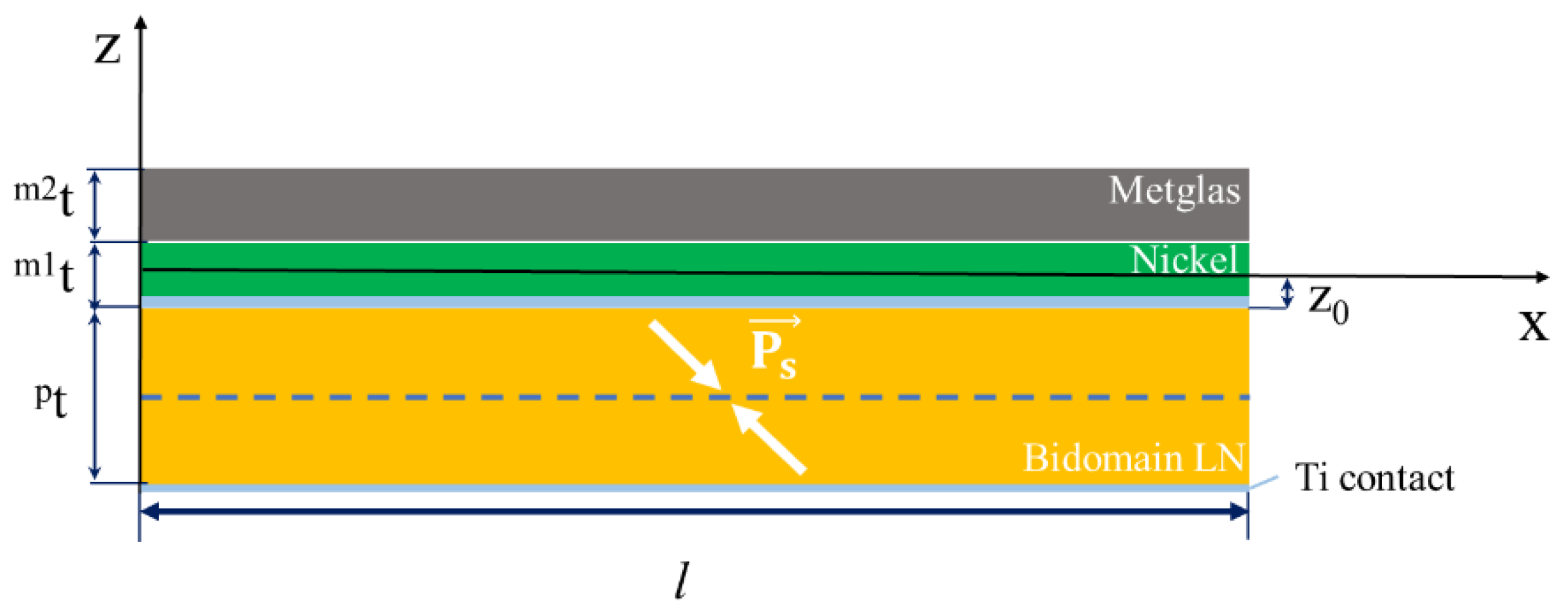
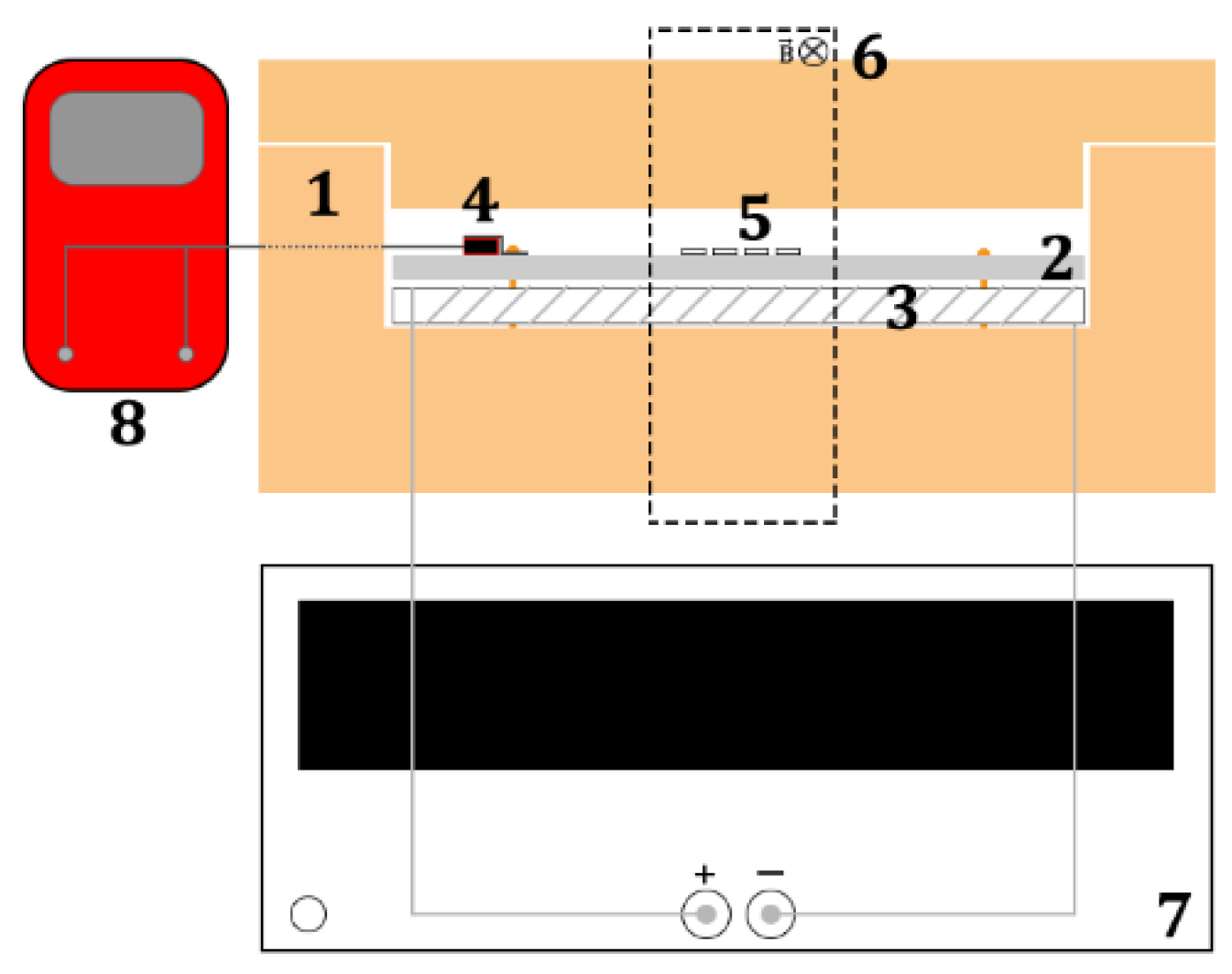
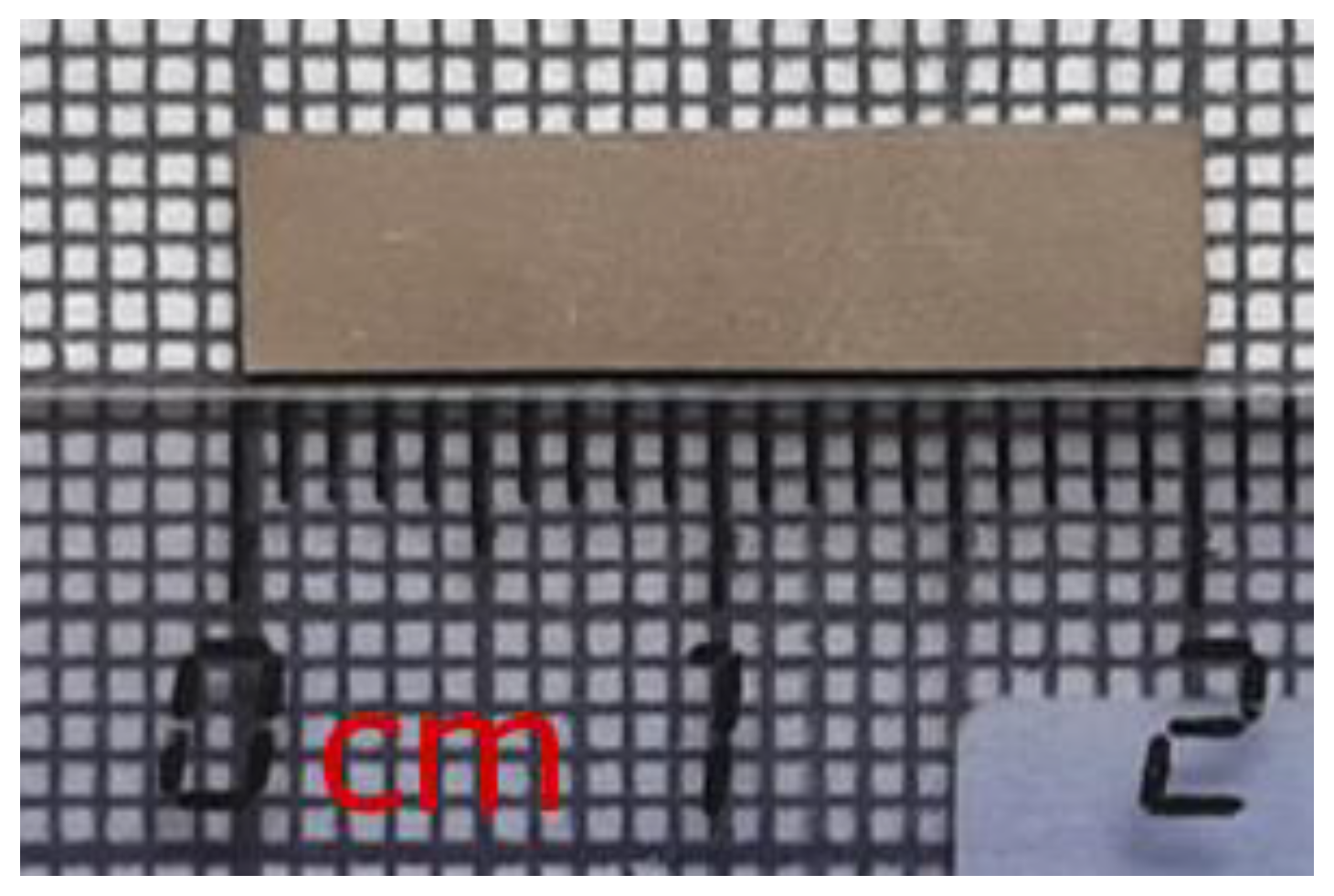
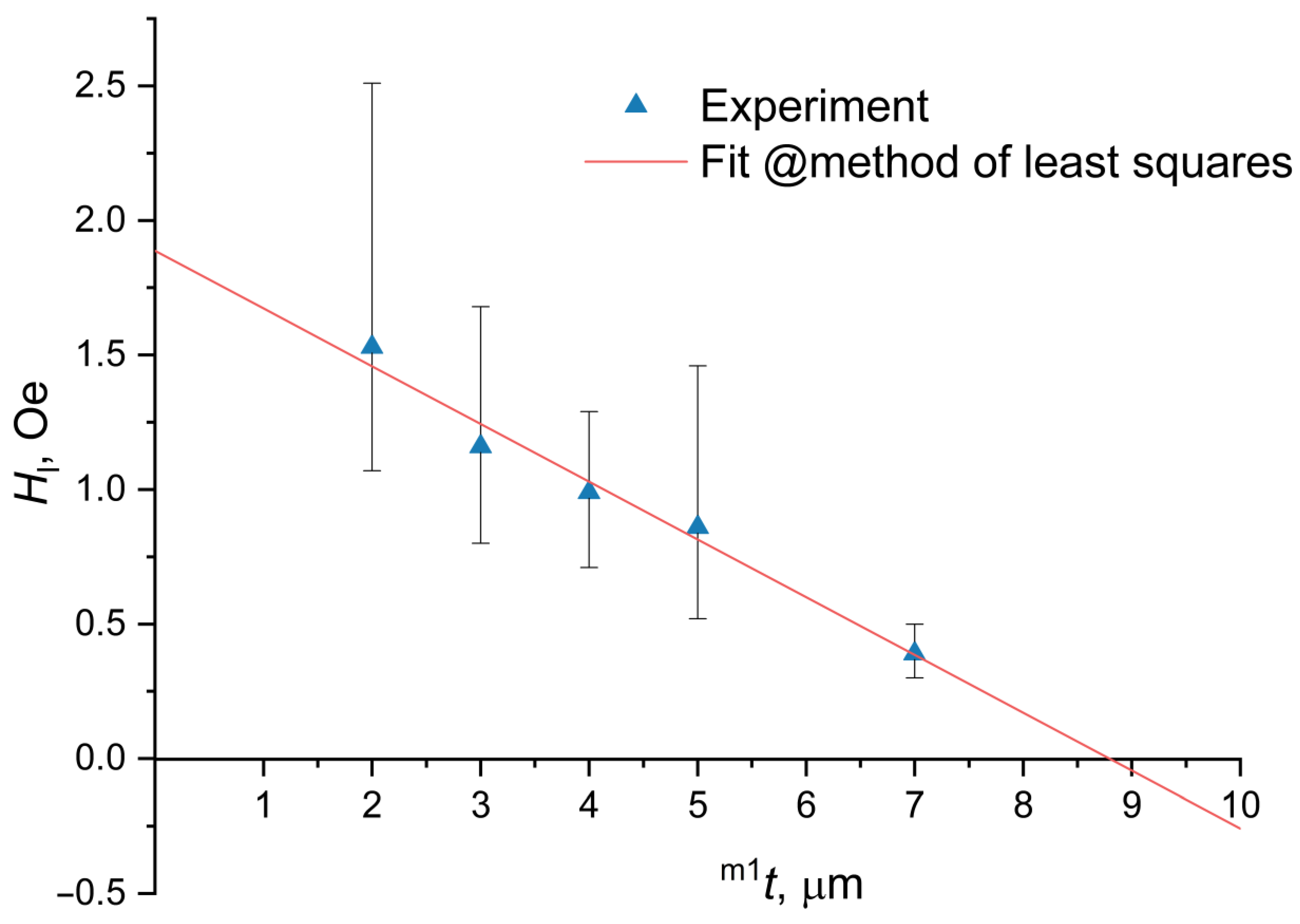
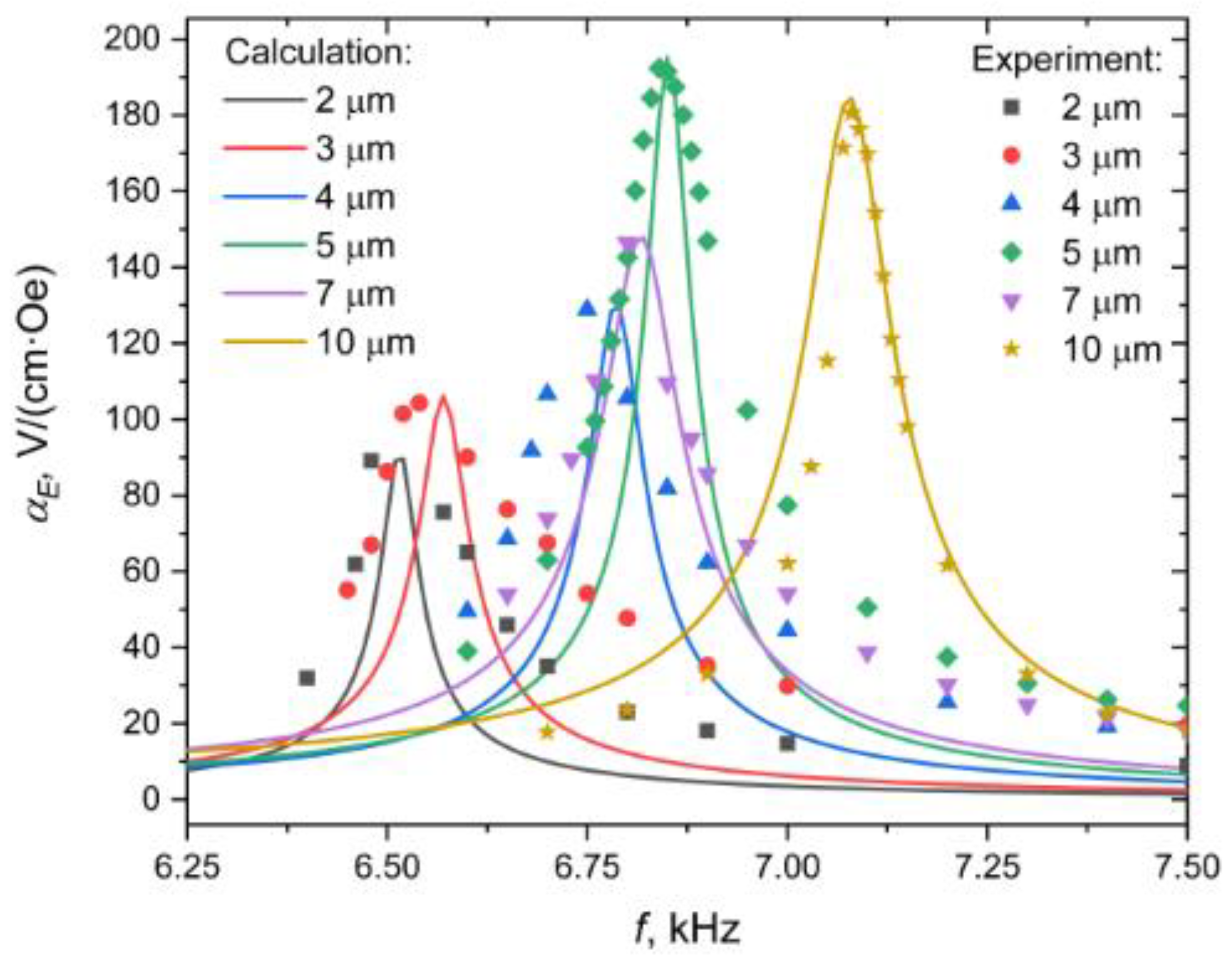
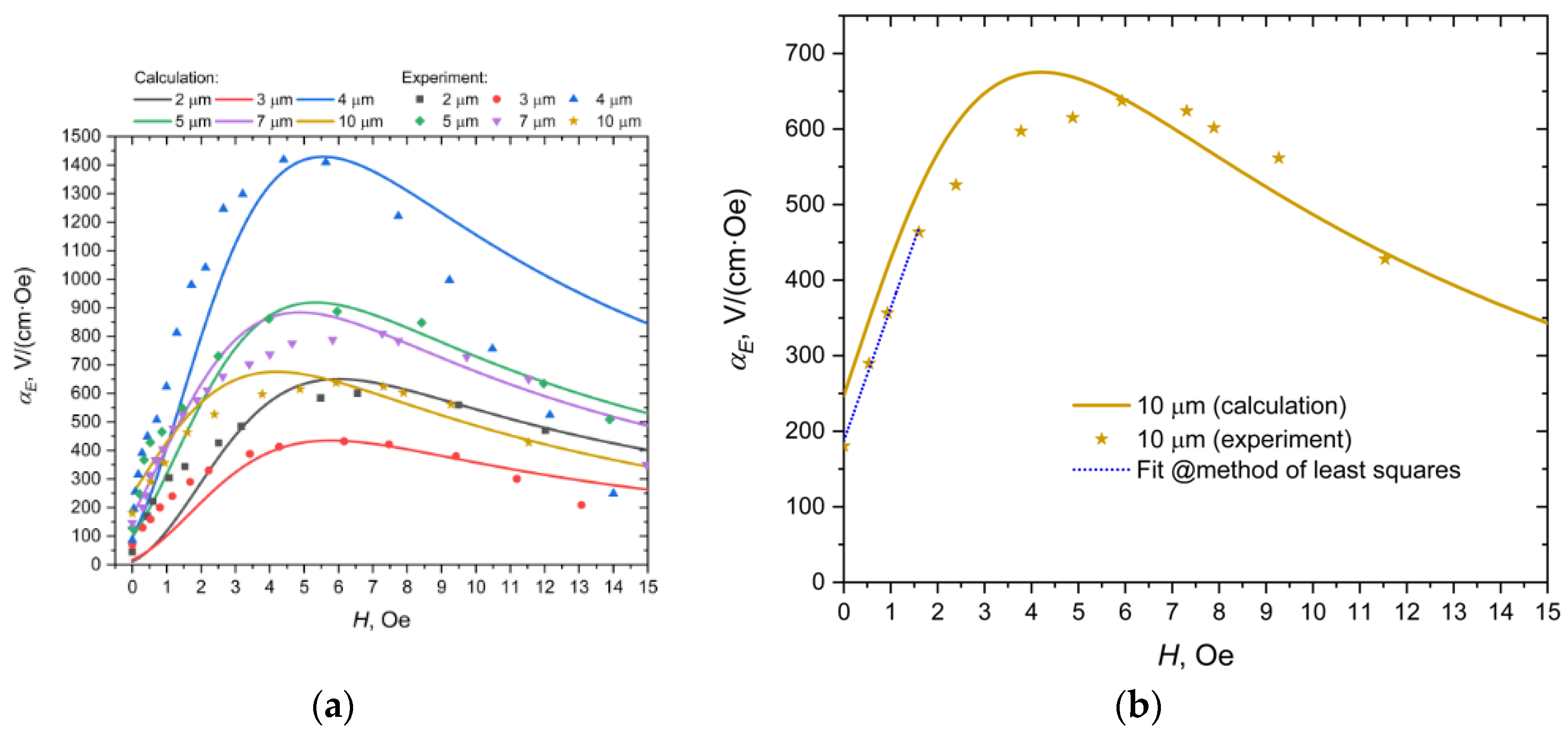
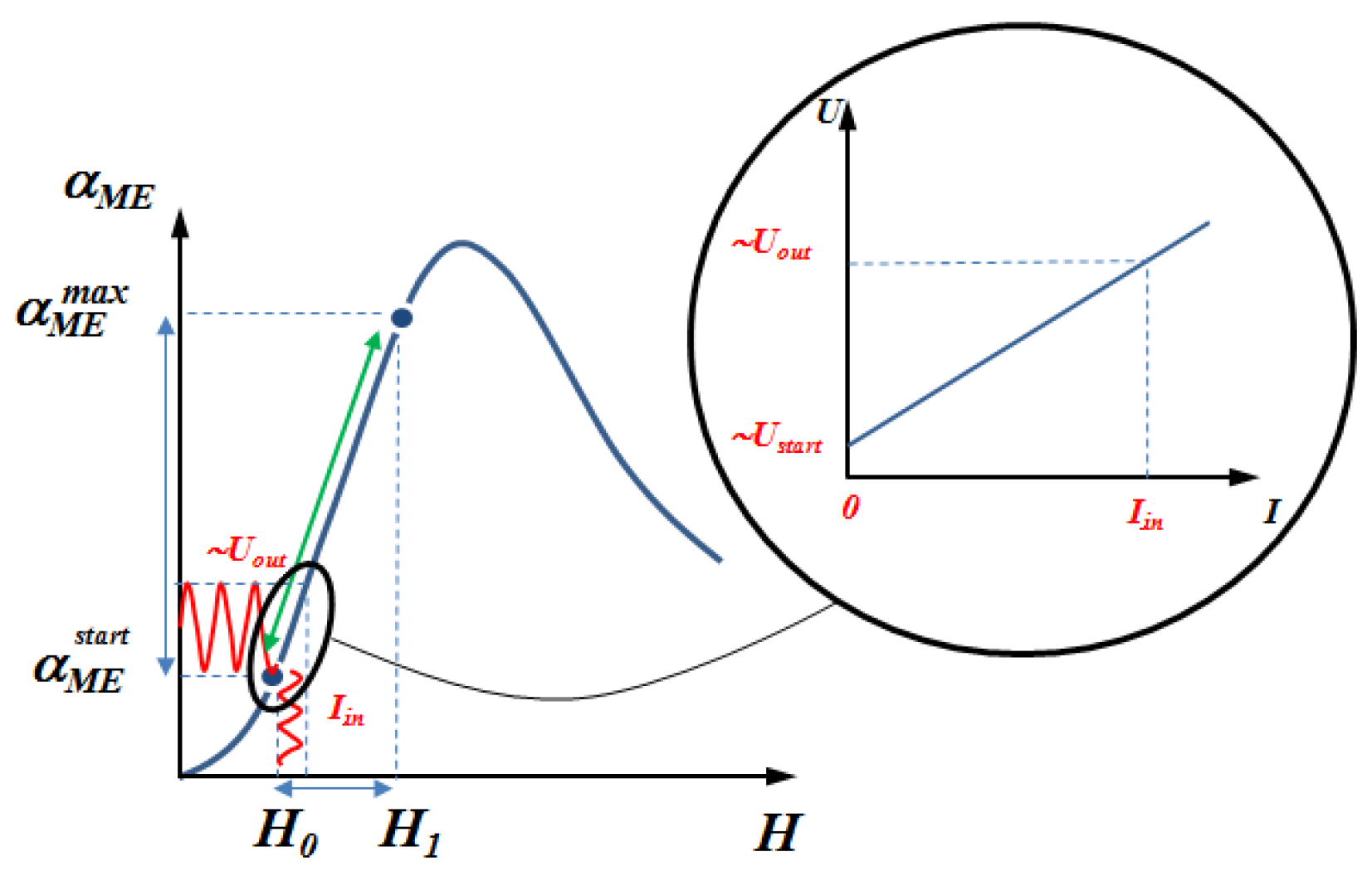
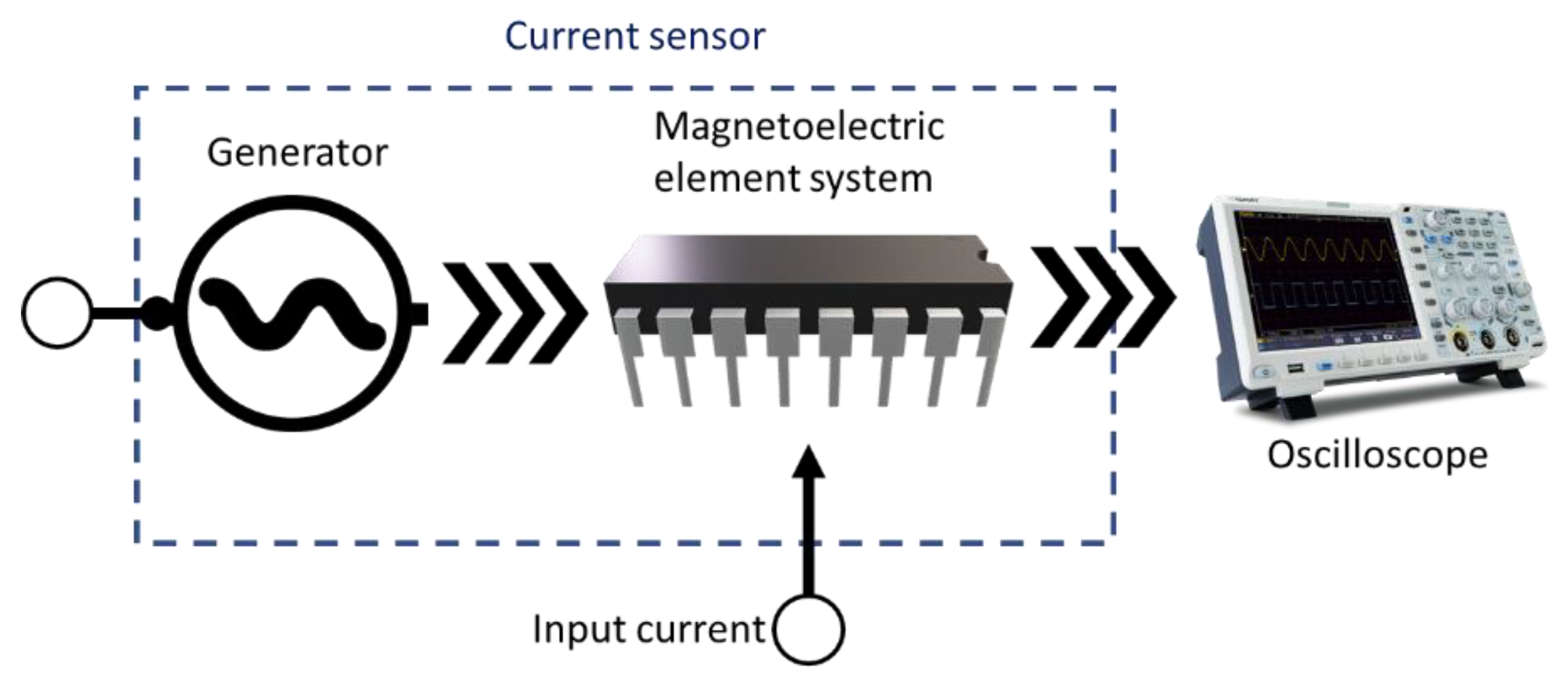
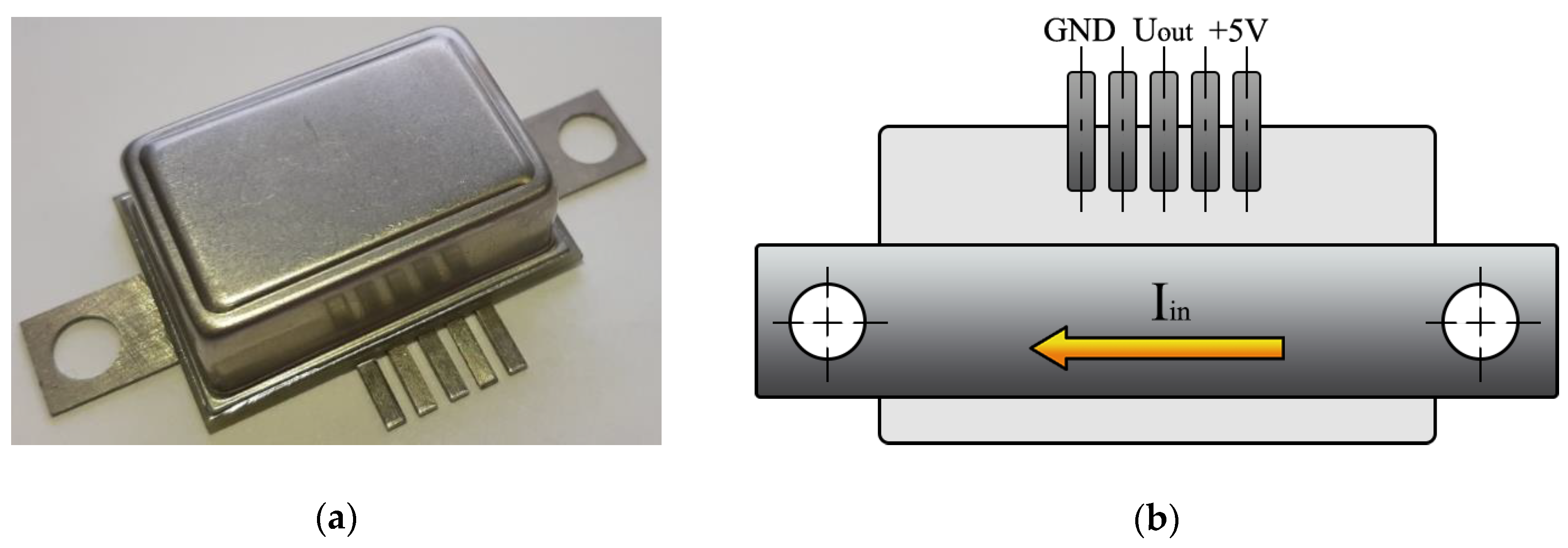
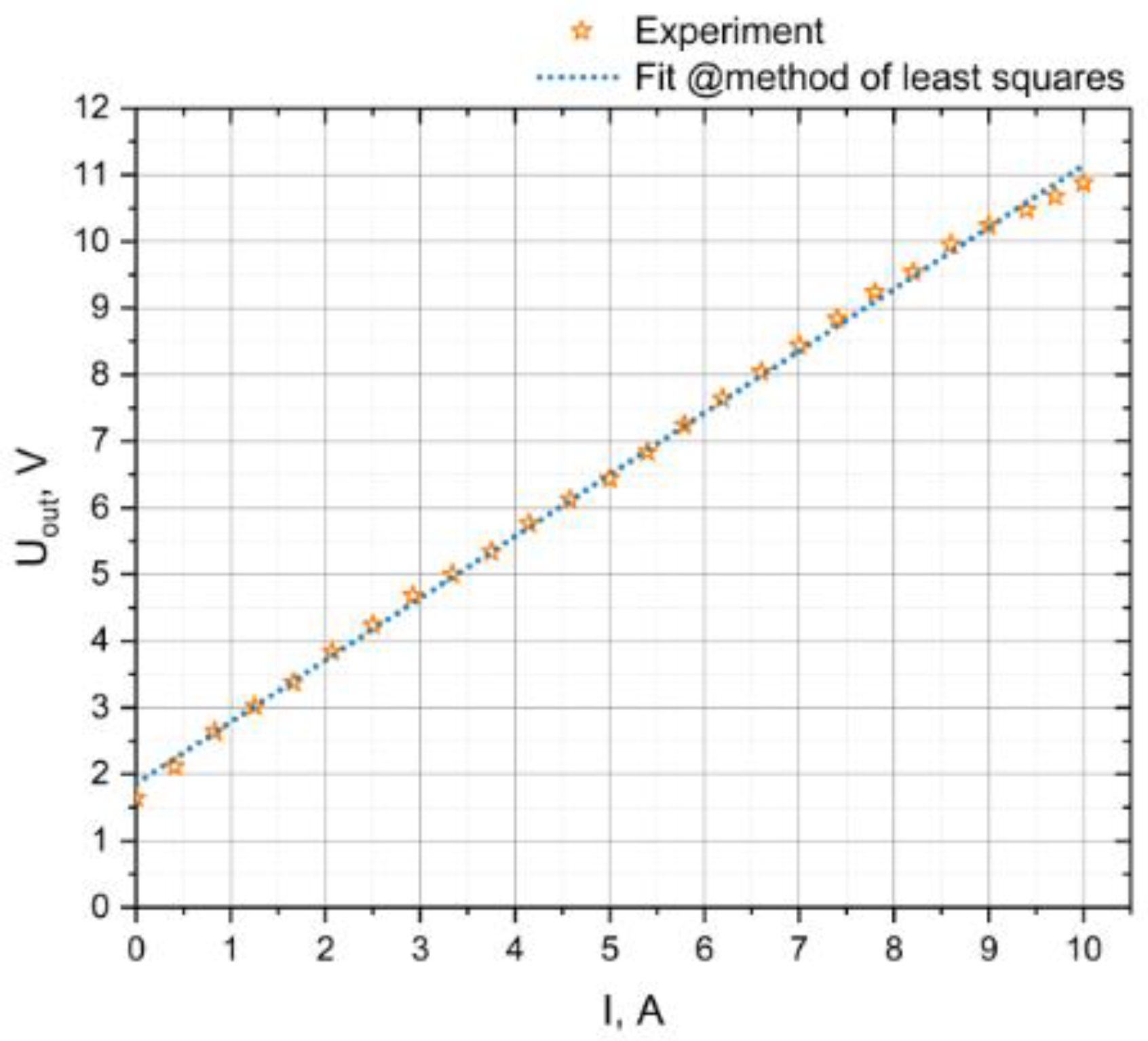
| Structure | Plate LN, mm | Thickness Ni, μm | Thickness Metglas, μm |
|---|---|---|---|
| Ti(100 nm)/LN/Ti(100 nm)/Ni/Metglas2826 MB | 20 × 5 × 0.5 | 2 | 29 |
| 3 | |||
| 4 | |||
| 5 | |||
| 7 | |||
| 10 |
| Sensors | Measuring Principle | Primary Current, Measuring Range, Ipm (A) | Sensitivity (V/A) | Supply Voltage (V) | Linearity (R2∙100), % | Output Voltage Range Uout (V) | Size (mm) | References |
|---|---|---|---|---|---|---|---|---|
| Magnetoelectric sensor | Magnetoelectric effect | 0–10 | 0.9 | 20 ± 5% | 99.8 | 1.64–10.88 | 30 × 20 × 10 | This paper |
| CSLW6B5 | Hall effect | ±5 | 0.2 | 4.5–10.5 | 98.9 | 2.7–3.7 | 16 × 14 × 10 | - |
| Magnetoelectric sensor (Metglas/PZT/Metglas) | Magnetoelectric effect | 0–5 | 0.53 | 5 ± 10% | - | 1.5–4.5 | 30 × 20 × 10 | [32] |
| Magnetoelectric sensor (Metglas/PVDF) | Magnetoelectric effect | 0–5 | 0.48 | - | 99.7 | 0–2.32 | - | [35] |
| Magnetoelectric sensor(SrFe12O19/FeCuNbSiB/PZT) | Magnetoelectric effect | 0–5 | 0.2 | - | 99.9 | 0–1 | - | [42] |
Publisher’s Note: MDPI stays neutral with regard to jurisdictional claims in published maps and institutional affiliations. |
© 2020 by the authors. Licensee MDPI, Basel, Switzerland. This article is an open access article distributed under the terms and conditions of the Creative Commons Attribution (CC BY) license (http://creativecommons.org/licenses/by/4.0/).
Share and Cite
Bichurin, M.I.; Petrov, R.V.; Leontiev, V.S.; Sokolov, O.V.; Turutin, A.V.; Kuts, V.V.; Kubasov, I.V.; Kislyuk, A.M.; Temirov, A.A.; Malinkovich, M.D.; et al. Self-Biased Bidomain LiNbO3/Ni/Metglas Magnetoelectric Current Sensor. Sensors 2020, 20, 7142. https://doi.org/10.3390/s20247142
Bichurin MI, Petrov RV, Leontiev VS, Sokolov OV, Turutin AV, Kuts VV, Kubasov IV, Kislyuk AM, Temirov AA, Malinkovich MD, et al. Self-Biased Bidomain LiNbO3/Ni/Metglas Magnetoelectric Current Sensor. Sensors. 2020; 20(24):7142. https://doi.org/10.3390/s20247142
Chicago/Turabian StyleBichurin, Mirza I., Roman V. Petrov, Viktor S. Leontiev, Oleg V. Sokolov, Andrei V. Turutin, Victor V. Kuts, Ilya V. Kubasov, Alexander M. Kislyuk, Alexander A. Temirov, Mikhail D. Malinkovich, and et al. 2020. "Self-Biased Bidomain LiNbO3/Ni/Metglas Magnetoelectric Current Sensor" Sensors 20, no. 24: 7142. https://doi.org/10.3390/s20247142
APA StyleBichurin, M. I., Petrov, R. V., Leontiev, V. S., Sokolov, O. V., Turutin, A. V., Kuts, V. V., Kubasov, I. V., Kislyuk, A. M., Temirov, A. A., Malinkovich, M. D., & Parkhomenko, Y. N. (2020). Self-Biased Bidomain LiNbO3/Ni/Metglas Magnetoelectric Current Sensor. Sensors, 20(24), 7142. https://doi.org/10.3390/s20247142








